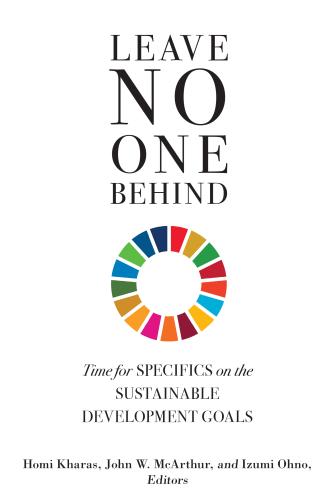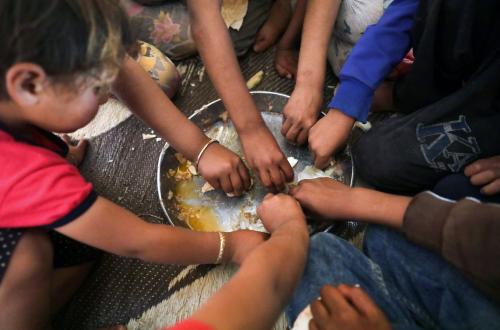The COVID-19 pandemic has not just exposed the cracks in our global health systems but demonstrated how much health matters for our economies. Many developing economies are at risk of being hit hard by dual health and economic shocks with forecasts suggesting a cost of up to 8 percent in global GDP in 2020.
Yet what is less well known is the chronic economic drag from poor health each year—about 15 percent lower GDP from premature death and lost productivity. For example, in low-income countries, infectious diseases such as tuberculosis (TB) present the largest losses to labor supply and household income. This means that globally, of the estimated 60 million deaths in 2020, 25 million people will die before they reach their 65th birthday. Or think of the 70 million children today who are malnourished, significantly curtailing their physical and cognitive development and reducing their productive potential.
So consider for a moment what would happen if avoidable health conditions were successfully addressed. Of course we know there would be immense benefits to individuals and societies. But what would the economic benefits be?
We analyzed almost 200 countries over the coming two decades to 2040 to identify the different health challenges and opportunities facing each. We determined what it would take to improve the health of the population and sized the benefits. The results were aggregated by regional and global levels and by levels of economic development and published in our new report “Prioritizing Health: A prescription for prosperity.”
While developing countries have made significant progress in the last two decades in improving health outcomes, they still lag significantly behind high-income countries. Our research shows that if we were to better use known interventions at more aspirational yet realistic rates of adoption, the economic payoff could be substantial.
We estimated a $4.4 trillion boost across all developing countries, or a 7 percent increase in GDP in 2040. The relative boost to GDP in 2040 varies between 7 and 11 percent among the different income archetypes. We also found an economic return of between $2 to $4 across developing countries for every $1 invested in health (Figure 1). Healthier children would benefit more from education and grow up to healthier adults with higher earnings potential, encouraging investment in education and productive capacity. Prioritizing health can be a catalyst for a broader virtuous cycle of growth.
Figure 1
A larger and healthier labor force translates into substantial economic benefits across all countries. Yet underlying differences in the health outcomes and labor market structure shape the opportunities individual countries have to capture those economic benefits (Figure 2). Highlights from two regions include:
- In Latin America, opportunities come from preventing and treating cardiovascular disease as well as reducing low back pain and vision impairment. The prevalence of blindness is much higher in Latin America than in the United States and mostly comes from cataract and refractive errors that are curable. Healthier working age people would be more likely to remain in the workforce and be more productive while working, which would contribute two-thirds of the 0.7 percent faster annual GDP growth.
- Sub-Saharan Africa would have 3.3 million more young adults alive by 2040 if the health of children were improved with better childbirth practices, treatment of lower respiratory diseases, and prevention of diarrhea and malaria, among others. The larger labor force would contribute over a third of the overall 0.5 percent faster annual GDP growth every year.
Figure 2
Prevention is better than cure, and about three-quarters of the untapped opportunity to improve health occurs from preventive measures such as vaccinations, better nutrition, and broader access to care for infectious and other treatable conditions. For developing countries, the cost of interventions is relatively low. More than half of the total health improvement opportunity identified in lower-middle-income countries could be delivered through interventions with incremental costs of less than $100 per year of healthy life gained. For example, midwife-assisted safe childbirth and childhood immunizations could deliver 1 percent of the total addressable disease burden for 0.1 percent of the total additional costs. In upper-middle-income countries in turn, prevention of cardiovascular disease with polypill and supported behavior change could be the highest impact intervention to improve health delivered at a relatively low incremental cost.
The pandemic has made investment in health even more urgent in low-income economies. The virus and its aftermath have led to disruptions in hugely important programs, such as child immunization, where at least 80 million children under 1 are at risk because of disruptions in vaccination efforts. Investing in health will also be key in building resilience toward other health risks from future pandemics, climate change, and antimicrobial resistance.
So how can these benefits be achieved? We identify a number of priorities:
- Make health a part of economic growth discussions. While health has long been recognized as a key aspect of development, investment decisions around health have too often been evaluated purely as a cost, not as an investment with an economic return. This is a mistake because improving health is necessary for prosperity. Healthier people are more productive in their prime working years and even more importantly, investing in child health will create the entrepreneurs, knowledge, and skilled workers of the future.
- Leapfrog to an integrated approach to health. The most effective health agenda balances environmental, social, and behavioral health and preventive care alongside acute treatment needs. The priorities vary across regions. Improving sanitation and limiting indoor pollution and expanding access to childhood vaccinations and infectious disease treatment are still challenging in the lowest-income regions. They also lag in infrastructure and training for comprehensive primary care, as well as informed and supported self-care. In middle-income countries, the focus needs to be on noncommunicable diseases, especially the rise of diabetes and cardiovascular diseases. These lifestyle diseases also highlight the need for nutritious food and safe outdoor spaces that make it easy for people grow, work, and age in a healthy way.
- Double down on innovation. For emerging economies, which typically get access to new medical treatments later, innovations in health care delivery will be needed to bring these interventions at a low cost to the millions of people who do not have them today. This means new funding and procurement models, broader partnerships and collaborations, and a broader set of common priorities. Technology can also play an important role, especially in scaling access. And pharmaceutical and medical technology companies could work to reduce the time delay.
As developing countries navigate and eventually emerge from the COVID-19 crisis, we have a once-in-a-generation opportunity to rethink the role of health in a post-pandemic future. Making health a priority and shifting focus to areas with highest return can improve resilience, reduce health inequity, and promote greater individual, social, and economic well-being.
The Brookings Institution is committed to quality, independence, and impact.
We are supported by a diverse array of funders. In line with our values and policies, each Brookings publication represents the sole views of its author(s).













Commentary
How investing in health has a significant economic payoff for developing economies
July 21, 2020